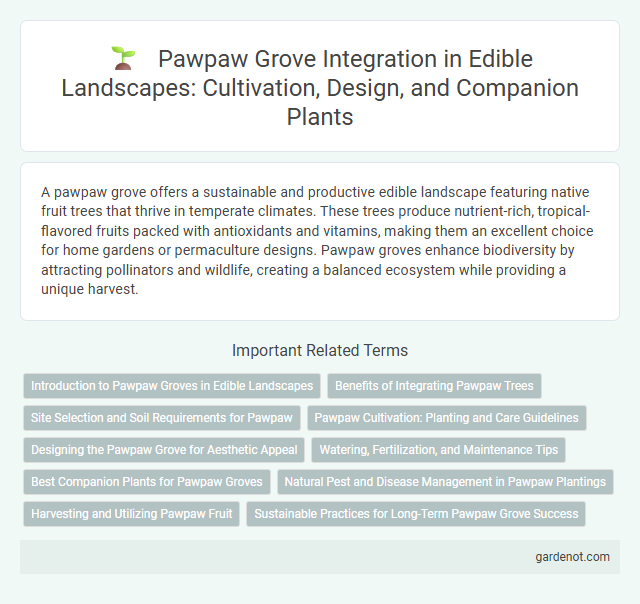A pawpaw grove offers a sustainable and productive edible landscape featuring native fruit trees that thrive in temperate climates. These trees produce nutrient-rich, tropical-flavored fruits packed with antioxidants and vitamins, making them an excellent choice for home gardens or permaculture designs. Pawpaw groves enhance biodiversity by attracting pollinators and wildlife, creating a balanced ecosystem while providing a unique harvest.
Introduction to Pawpaw Groves in Edible Landscapes
Pawpaw groves provide a unique and sustainable option for edible landscapes, featuring native North American trees that produce nutrient-rich fruits with custard-like texture and tropical flavor. These groves thrive in shaded, well-drained soil, making them ideal for understory planting in diverse garden ecosystems while supporting local wildlife and pollinators. Incorporating pawpaw groves can enhance biodiversity, reduce maintenance costs, and supply fresh, organic fruit for home consumption or community markets.
Benefits of Integrating Pawpaw Trees
Integrating pawpaw trees into edible landscapes enhances biodiversity by attracting pollinators and providing unique habitat. Pawpaw groves offer nutrient-rich, low-maintenance fruit that supports local food security and promotes sustainable gardening. Their deep root systems improve soil health by reducing erosion and increasing organic matter.
Site Selection and Soil Requirements for Pawpaw
Selecting an optimal site for a pawpaw grove involves choosing well-drained, fertile soils with a slightly acidic to neutral pH between 5.5 and 7.0. Pawpaw trees thrive in deep, loamy soils rich in organic matter that retain moisture but avoid waterlogging, ensuring root health and vigorous growth. Ideal locations provide partial shade during early growth stages and protection from strong winds to support the delicate pawpaw's nutrient uptake and fruit production.
Pawpaw Cultivation: Planting and Care Guidelines
Pawpaw cultivation thrives in well-drained, slightly acidic soils with partial shade to mimic their native understory habitat. Plant young pawpaw trees 10 to 15 feet apart to ensure adequate space for root and canopy development, and maintain consistent moisture during the growing season to promote healthy growth. Regular mulching and protection from strong winds enhance fruit production and reduce pest stress in a pawpaw grove.
Designing the Pawpaw Grove for Aesthetic Appeal
Designing a pawpaw grove for aesthetic appeal involves strategic spacing to enhance visual flow and ensure optimal sunlight exposure, promoting healthy tree growth and vibrant foliage. Incorporating diverse understory plants like ferns and native wildflowers creates textural contrast and seasonal interest, enriching the sensory experience. Integrating curved pathways and naturalistic seating areas within the grove encourages immersive interaction with the landscape while showcasing the pawpaw's unique tropical leaves and fragrant blossoms.
Watering, Fertilization, and Maintenance Tips
Pawpaw groves require consistent watering, especially during dry spells, to ensure healthy fruit development, aiming for deep, infrequent irrigation to encourage strong root growth. Fertilization should focus on balanced applications of nitrogen, phosphorus, and potassium in early spring, supplemented by organic matter like compost to enhance soil fertility. Regular maintenance includes mulching to retain moisture, pruning to improve air circulation, and monitoring for pests such as the pawpaw peduncle borer to maintain grove health and productivity.
Best Companion Plants for Pawpaw Groves
Pawpaw groves thrive when planted alongside nitrogen-fixing plants like black locust and native legumes, which enhance soil fertility and promote healthy growth. Shade-tolerant companions such as serviceberry and spicebush improve microclimate conditions, offering partial shade and wind protection. Incorporating ground covers like wild ginger and ferns reduces weed competition and retains soil moisture, optimizing overall grove productivity.
Natural Pest and Disease Management in Pawpaw Plantings
Pawpaw groves benefit from natural pest and disease management through diversified planting and habitat conservation that encourages beneficial insects and predators. Maintaining leaf litter and understory vegetation supports microbial communities that suppress soil-borne pathogens, reducing the need for chemical interventions. Integrating native companion plants enhances pest resistance by attracting pollinators and deterring harmful pests naturally.
Harvesting and Utilizing Pawpaw Fruit
Harvesting pawpaw fruit requires careful timing, as the fruit is ripe when it yields slightly to gentle pressure and emits a sweet aroma. To utilize pawpaw fruit effectively, it can be consumed fresh, blended into smoothies, baked into bread or muffins, or used to create jams and desserts rich in tropical flavors. Storing pawpaw fruit in a cool environment extends shelf life, while freezing puree preserves the fruit for year-round use in various recipes.
Sustainable Practices for Long-Term Pawpaw Grove Success
Implementing sustainable practices in a pawpaw grove includes maintaining soil health through organic mulching and cover cropping to enhance nutrient cycling and water retention. Integrating native pollinators and natural pest management reduces chemical inputs, promoting ecological balance and fruit quality. Regular pruning and proper site selection based on sunlight and soil drainage ensure long-term productivity and resilience of the pawpaw grove.
Pawpaw grove Infographic

 gardenot.com
gardenot.com